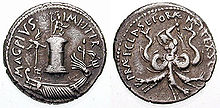Scylla
Skylla (also Scylla or Szylla ; Greek Σκύλλα) is a sea monster from Greek mythology with the upper body of a young woman and a lower body that consists of six dogs. A famous Hellenistic group of statues from Sperlonga , the so-called Scylla group, shows the monster attacking Odysseus and his men.
mythology
There are various legends about Skylla. According to Ovid, she is the daughter of the nymph Krataiis and is courted by Glaucus . Because Skylla does not reply, Glaukos goes to the sorceress Kirke to at least be healed by the fiery glow of love. But Kirke is jealous of Scylla because she has fallen in love with Glaukos herself. And so Kirke poisoned the water in which Skylla likes to stay. After she took a bath there and got out of the water, six dog heads and twelve dog feet grow out of her abdomen. Skylla then lives opposite another monster named Charybdis on a rock on the strait between Sicily and Italy. Together they are two inevitable, equally great evils. She (Skylla) eats everything that is alive and comes within her reach, and with her tentacles she takes hold of careless seafarers who come too close to her because they want to escape Charybdis. When Odysseus drives through the narrowness, she eats six of his companions.

In some sources Scylla is also associated with Skylla , the daughter of Nisos . According to another family tree of the Greek gods , Scylla is descended from Phorkys and Hecate .
In his 79th letter to Lucilius, Seneca mentions a rock called Scylla, which is not that dangerous for shipping either. The place Scilla on the Strait of Messina is named after the Scylla, where, according to later legends, it is said to have lived.
The Norwegian monk Theodoricus Monachus (12th century) believed Pentland Firth to be the strait of Scylla and Charybdis.
In his book Homer's Wild West , published in 2008, the historian Heinz Warnecke assumes that the real place for Scylla is the strait of Rhion between the Gulf of Patras and the Gulf of Corinth. Weather phenomena still produce waterspouts here, which in ancient times were interpreted as the arms of a monster that sailors could tear off the deck of their ships.
Phrase
In everyday language, Skylla appears in the phrase "between Scylla and Charybdis". This denotes a dilemma in which one is faced with a hopeless choice between two evils or between two inevitable dangers. It is impossible to get out of this dilemma without harm.
Individual evidence
- ↑ Ovid metamorphoses 13, 730-749 and 898-968 as well as 14, 51-74
- ↑ Homer, Odyssey 12, 222-259.
- ↑ Virgil, Eclogae 6: 74-77; Properz, Elegiae 4, 4, 39-40.
- ↑ Lars Ivar Hansen and others: "Nordens plass i middelalderens nye Europa: Samfunnsomdanning, sentralmakt og periferier". In: Nordens plass i middelalderens nye Europa: Samfunnsomdanning, sentralmakt og periferier. Rapporter to the 27. nordiske historikermøte, Tromsø 11. – 14. august 2011. Tromsø 2011 .
- ↑ Heinz Warnecke: Homer's Wild West: The historical-geographical rebirth of the Odyssey. Stuttgart 2008, ISBN 978-3-515-11621-3 .
- ↑ Language project Skylla and Charybdis (PDF file)
- ↑ Quotations - idiom - between Scylla and Charybdis. In: seefelder.de. February 25, 2008, accessed October 6, 2016 .
